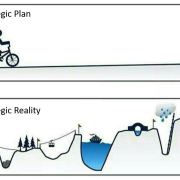Become extraordinary by making your history a bridge to the future
Most people base their view of what’s possible in the future on what has happened previously – their history, including all things leading up to the moment they contemplate beyond ‘now’.
While it’s normal to base our worldview on past experiences – and this is as true for individuals as it is for organisations – this belief that history pre-determines our future can create a chasm between current reality and new possibility. 
But extraordinary leaders don’t allow this historical perspective to be a limitation. They use their history to their advantage. They make their history and experience a bridge between the current condition and aspirational possibilities – their vision for the future.
Most of the work I do with my clients is future-focused – strategic execution and business improvement. This work necessitates a conversation around what is currently so and what the business aspires to. I consistently see aspiration defined in terms of either the present or the past. When I press teams to describe an idealised future state that is unencumbered by current limitations, if only in vague or conceptual terms, they often struggle to see beyond these limitations.
One client that I am working with has a highly unionised workforce. As I talked to them about creating improvement projects that bring their people’s operational understanding and expertise together with the business’s strategic purpose, they struggled to see beyond the historical divide that exists between management and workers. It was as if this divide needed to be removed to envision this future state, instead of one that had to be bridged in order to attain it.
Another client that wants to drive organisational improvement comes from the construction industry. This is an industry that has managed and delivered projects in much the same way for over 50 years. It is also an industry that, over this same period, has not improved its productivity. As the projects and business world becomes more complex, the level of failure consistently increases. Yet the industry’s aspiration for improvement is largely based on trying to do what it has always done – just a little better. It’s an industry stuck in the belief that ‘this is as good as it gets’; one where ineffectiveness is tolerated because there is rarely an example of anything better.
Your history are the building blocks for your future – use them wisely
I tend to think of this accumulated history like a collection of bricks. Some define your organisational culture and ‘how things are done around here’; others define personal accomplishments and failures; still others form a collective perception of the market or business environment. We can’t help but use these bricks to shape our future and craft our aspiration – but are we using them to build a wall, or a bridge?
A great many teams and organisations use these bricks to build a wall. A wall that, at a minimum, is an impediment to moving into the future. Something that you have to go around or over if you’re to find a different future. At worst, this walls stops them from being able to see the future at all.
Exceptional organisations have leadership that uses these bricks to build a bridge to the future that they wish to create – to the strategic vision that appears only in wispy, ephemeral glimpses on the horizon. These organisations recognise that not all of the bricks are useful and some shouldn’t be part of this aspirational structure. They also recognise that they have other building materials at their disposal.
Start doing, stop doing and keep doing
In 9 out of 10 strategy-making sessions, the discussion orbits around the question: ‘what things do we want to start doing, stop doing and keep doing?’. Unfortunately it is often done in this incremental manner with the expectation that these complex actions are like taps that get turned on or off on command.
These questions should really act as a filter for the parts of your history that can help you to achieve the future state your organisation needs to reach. They provide valuable insights to ensure that current conditions don’t limit your possibilities. They present an opportunity to determine how the past can inform strategic decision-making.
Global brands such as Lego and Apple have learned that a rich history can be used to design a vibrant future. When sportswear manufacturer Adidas was facing record losses after failing to keep pace with Nike it turned to its heritage and previous successes. PWC’s Strategy + Business magazine reported that in “a process full of both continuity and change, the company reaches back to the lessons of the past and stretches forward to adapt to the changing needs of [the market]”.
Here are three ways that extraordinary leaders leverage their history to create a new business future:
- Take inspiration from your accomplishments. Whether achieving exceptional results or overcoming significant adversity, accomplishment can be the driving force of a future-facing organisation. Too often we dwell on the shortcomings in past performance at the expense of recognising our successes. It is very difficult to step into the unknown and to take risks when the business remains mired in all that has gone wrong. Studies have consistently shown that progress is the greatest motivator for people in the workplace and it is also highly correlated with business creativity. Additionally, innovation, exploration and experimentation only flourish when the ability to overcome adversity and failure are recognised organisational attributes.
- Your strengths make the best foundation. Any structure – and businesses are no different – is going to perform at its best when it’s built on a strong foundation. One of the most useful applications of your history is the identification of your organisational strengths. Strength in this context is the identification of your best business qualities, not necessarily where you get the best business results. Often these strengths will be linked to capabilities and culture that are an extension of your people and teams. Weaknesses shouldn’t be ignored and they should be the target of active improvement activities, but shoring up these weaknesses should not be the base upon which your future is built.
- ‘Past performance is not an indication of future success.’ This admonishment accompanies any personal investment advice and yet it is often ignored when investing in a business’s future. One of the most insidious limitations that our history places on an organisation is its success. The fast-changing business environment of today is full of examples of businesses that have clung desperately to past successes – products, services, operating models – while the market or their customer base moved on. Past performance is useful only when it is framed against a future business environment. Is it a market need that is growing or eroding? Is it a customer base that is looking for more or better than our current offerings? Can our historical performance be leveraged into new markets or to stay ahead of emerging competition?
Today’s business world requires constant adaptation and consistent innovation. It’s the leaders that use their history to create a future that keep pace with this change that will thrive. Those that remain anchored in their past will watch as the future races away from them.
Questions for consideration
As leaders look forward to create a strategic vision or set long-term goals, it’s important to ensure that future state is both informed by what your history tells you is possible but is not limited by what is currently holding you back. So when you contemplate the gap between where your business is now and where you aspire to be, consider these questions:
- How can I use the past to make strategic decisions that move the business forward?
- How do we use our history to alleviate the fear of the unknown and be bold in the face of change?
- When is our past and/or our present limiting our view of what might be possible?
Never miss a post: sign up to the Projectifying Business fortnightly newsletter here








May I simply say what a comfort to discover someone who truly understands what they’re discussing on the internet. You actually know how to bring an issue to light and make it important. More people must read this and understand this side of the story. I was surprised that you aren’t more popular given that you most certainly possess the gift.